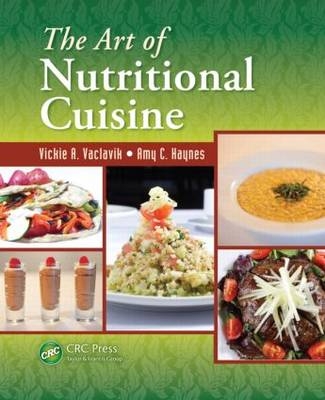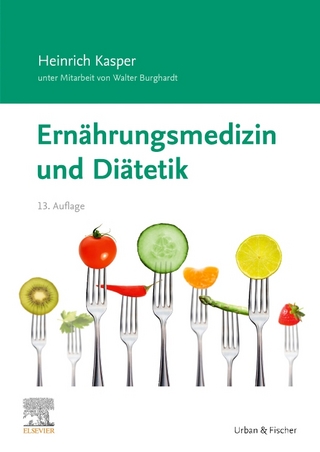
The Art of Nutritional Cuisine
Crc Press Inc (Verlag)
978-1-4398-5083-1 (ISBN)
- Titel ist leider vergriffen;
keine Neuauflage - Artikel merken
Includes Material for Classroom Lectures and Laboratory Practicum
The lecture portion of the book includes:
A glossary of key terms
Teachable Moments to amplify the application of basic food science concepts
Recommended websites to facilitate further study
References to USDA guidelines to assist in planning and achieving a healthy diet
Appendices elaborating on pertinent topics in nutrition and nutritional cooking
Ample space for reader notes to be added to the text
Recipes and Sample Menus
The lab portion of the text offers the opportunity to apply basic nutritional principles in the kitchen and equips readers with the ability to prepare tasty and healthy cuisine. It includes recipes and sample menus that enable application of the lecture material. Using classic culinary techniques while adhering to sound nutritional principles, professional and home chefs can create tasty meals that promote good health.
Vickie A. Vaclavik is a registered dietitian who has taught for more than 25 years at the college level in Dallas, including at the Dallas County Community College District; the University of Texas Southwestern Medical Center at Dallas, Nutrition Department; and The International Culinary School at The Art Institute of Dallas. Dr. Vaclavik is a graduate of Cornell University where she studied Human Nutrition and Food. She also studied at Purdue University, majoring in Restaurant, Hotel, Institution Management, and at Texas Woman’s University, studying Institution Management and Food Science. She is the lead author of Dimensions of Food since its third edition. She also wrote Essentials of Food Science, now in its third edition with two foreign translations. Amy Haynes is a registered dietitian who specializes in the application of nutrition in the kitchen. She earned her degree from The University of Texas Southwestern Medical Center in Dallas and has acquired various experiences within the food service industry over the last 20 years. She has been an instructor at The International Culinary School at The Art Institute of Dallas since 2000, and continues to inspire aspiring chefs to incorporate healthy foods and practices into their cuisine. She has made it her own personal goal to promote healthy living with experiences ranging from teaching fitness classes to being featured as a “guest chef” at the renowned Hilton Head Health Institute in South Carolina. Read an interview with Amy Haynes at the University of Texas Southwestern Medical Center website (2009).
PART ONE: LECTURE CHAPTERS
An Introduction to Nutritional Cuisine and a Healthy Diet
Nutrients
Portion Sizes
Calories
Dietary Reference Intake
Acceptable Macronutrient Distribution Ranges (AMDR%)
Diet Planning
Personalized Food Plan
Nutritional Assessment
Malnutrition, Deficiency, and Disease
Putting the Principles for a Healthy Eating Pattern into Action
Enriched and Fortified Foods
Food Labels and the Law
Restaurant Labeling of Foods
Food Label Display
Food Allergen Labeling
Label Claims
Approved Claims
Food Additive Labeling: "Generally Regarded as Safe" Status
Carbohydrates: Digestion, Absorption, Metabolism, and More!
Carbohydrate Definition
Simple Carbohydrates
Complex Carbohydrates
Digestion, Absorption, and Metabolism of CHO
Blood Glucose Regulation
Exchange List
Lactose Intolerance
Food Application: Vegetables
Food Application: Using Starch
Carbohydrate-Rich Diets
Labeling: Carbohydrates
Food Groups
Fats: Digestion, Absorption, Metabolism, and More!
Lipids in General
Triglycerides (TG)
Phospholipids
Sterols
Digestion, Absorption, and Transport of Lipids
Health Implications of LDL, HDL, and Trans Fat
Metabolism
Exchange List
Health and Lipids
Food Preparation Application
Labeling: Lipids
Food Groups
What Are "Oils"?
Protein: Digestion, Absorption, Metabolism, and More!
Structure of Protein
Complete and Incomplete Proteins
Reference Protein
Nitrogen Balance
Functions of Protein
Denaturation of Protein
Digestion, Absorption, and Metabolism of Protein
Protein Requirements
Allergies and Intolerances Associated with Proteins
Vegetarianism
Menu Planning for Vegetarians
Food Preparation Application
Labeling: Proteins
Food Groups
Food Groups
References
NutriFacts—Beef and Veal
NutriFacts—Chicken and Turkey
NutriFacts—Pork and Lamb
NutriFacts—Seafood
Vitamins and Good Health
Overview and Information regarding Vitamins
Water-Soluble B Vitamins
Vitamin C (Ascorbic Acid)
The Fat-Soluble Vitamins: A, D, E, and K
Vitamin A and Beta-Carotene
Vitamin D: The Sunshine Vitamin
Vitamin E: The Tocopherols
Vitamin K
Effect of Cooking on Vitamins
Non-Nutrients in Foods
Biotechnology
Organic Foods
Conclusion
Vegetable Nutri-Facts
Fruit Nutri-Facts
Extra: Effect of Cooking on Vegetable Pigments
Minerals, Water, and Good Health
Overview of Minerals
Major (Macro) Minerals
Trace (Micro) Minerals
Minerals on the Menu
Labeling: Minerals
Water and Good Health
Weight Management for Good Health
Balancing Calories to Manage Weight
Weight Formulas
Healthy Weight
Body Mass Index (BMI): A More Reliable Weight Measure
Health Implications of Obesity
Fad Diets
Diet and Exercise
Exercise Recommendations
Extra: What Are "Empty Calories"?
Key Consumer Messages
Culinary Skill for Nutrition and Disease
Disease and Risks
Cardiovascular Disease
Heart Disease
Stroke: Cerebrovascular Diseases
Cancer: Malignant Neoplasm
Diabetes Mellitus
Dietary Guidelines
Food Service Guidelines
Fitness and the Chef
Physical Fitness: The White House Press Release
Becoming Physically Fit
Aerobic and Anaerobic Exercise
Benefits of Regular Physical Activity
Dietary Guidelines
Muscle Response to Demand
Safely Exercise
Water and Fitness
Menu Planning and Fitness
Nutrition, Athletic Training, and Fitness
Eating Well throughout the Life Cycle:
From Pregnancy to Senior Adults
Pregnancy
Nutrition during Lactation
Infancy
Childhood
Youth and Adolescence
Senior Adults
Menu Planning in the World of Nutritional Cuisine
The Menu: Defined
Menu-Planning Considerations
Menu-Planning Tools
Number of Menus Needed
Major Parts of the Physical Menu
Writing the Menu
My Menu Applications
PART TWO: LABORATORY EXERCISES
Lab 1: Introduction
Lab Outline
Planning: Getting Ready
Measurement Equivalents
Lab Time: Getting Set
Lab Time: Go!
Nutritional Cuisine: Principles and Guidelines
Evaluation of Foods
Subjective Evaluation of Foods
Objective Evaluation of Foods
Putting It into Practice
Lab 2: Carbohydrates, Fats, and Oils
Lab Outline
Identifying Carbohydrates
Identifying Fats and Oils
Putting It into Practice
Lab 3: Identifying Protein
Lab Outline
Identifying Good Sources of Protein
Safe Minimum Cooking Temperatures
Why Rest Time Is Important
Putting It into Practice
Lab 4: Vitamins and Minerals: Plant-Based Foods
and the Nutrients They Offer
Lab Outline
Storage, Preparation, and Cooking
Putting It into Practice
Further Reading
Lab 5: Nutrient Analysis
Lab Outline
Diet versus Recipe Analysis
Putting It into Practice
Lab 6: Midterm Practical
Lab Outline
Part I: Preparation and Presentation of Menu in Groups
Part II: Nutrient Analysis and Report
Lab 7: Baking for Health: Decreasing Fat and Increasing
Fiber in Baking
Lab Outline
Reducing Fat (and Calories!) in Baked Goods
Eggs: Replacing or Reducing Eggs in Baked Goods
Increasing Fiber: Baking with Whole-Grain Flours
Putting It into Practice
Lab 8: Cooking for Weight Management
Lab Outline
Menu Trends
Putting It into Practice
Lab 9: Special Diets and Disease
Lab Outline
Common Food Intolerances and Allergies
Heart Disease, High Blood Pressure, Cancer, and Diabetes
Other Diseases and Disorders with Dietary Restrictions
Putting It into Practice
Lab 10: Locating Special Ingredients
Lab Outline
Locating Special Ingredients
Sustainable Agriculture
Certified Organic Foods
Buying Local
Buying Seasonal
Feeding Today’s Kids
Accommodating Dietary Restrictions
Putting It into Practice
Lab 11: Final Practical
Final Practical
Final Practical: 2 Parts
GLOSSARY
APPENDICES
INDEX
| Zusatzinfo | 69 Tables, black and white; 203 Illustrations, black and white |
|---|---|
| Verlagsort | Bosa Roca |
| Sprache | englisch |
| Maße | 191 x 241 mm |
| Gewicht | 1520 g |
| Themenwelt | Medizin / Pharmazie ► Gesundheitsfachberufe ► Diätassistenz / Ernährungsberatung |
| Naturwissenschaften ► Biologie | |
| Technik ► Lebensmitteltechnologie | |
| Weitere Fachgebiete ► Handwerk | |
| ISBN-10 | 1-4398-5083-6 / 1439850836 |
| ISBN-13 | 978-1-4398-5083-1 / 9781439850831 |
| Zustand | Neuware |
| Haben Sie eine Frage zum Produkt? |
aus dem Bereich


